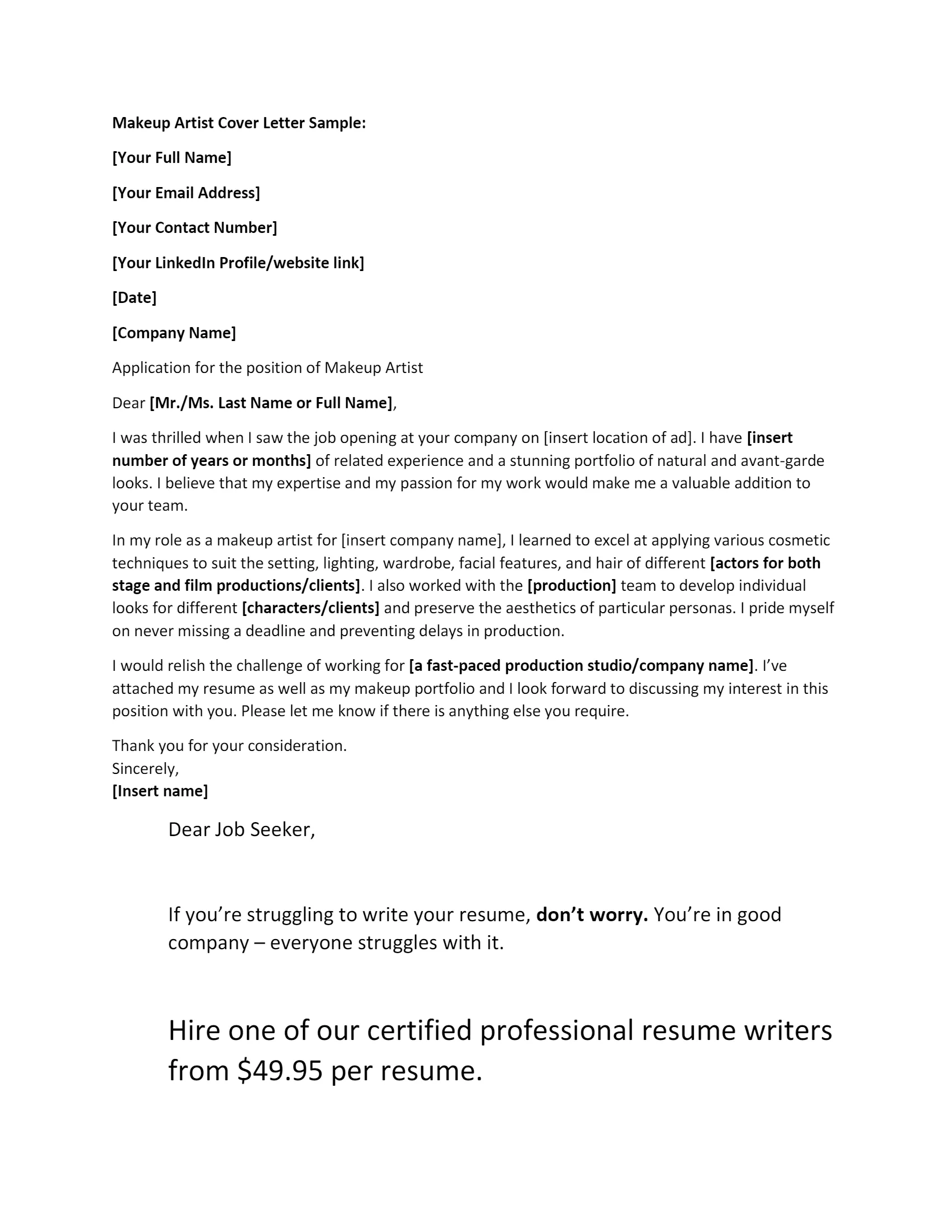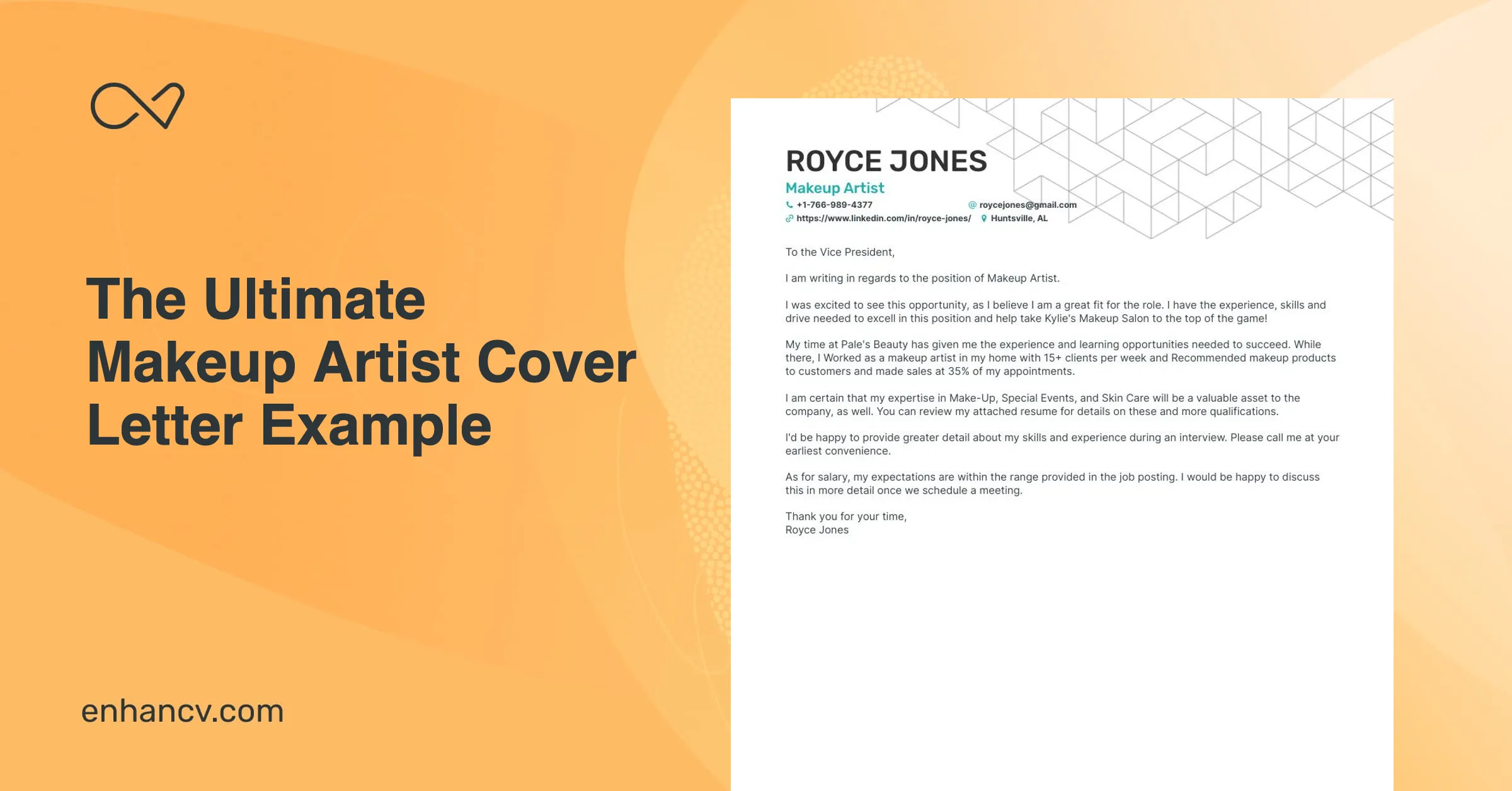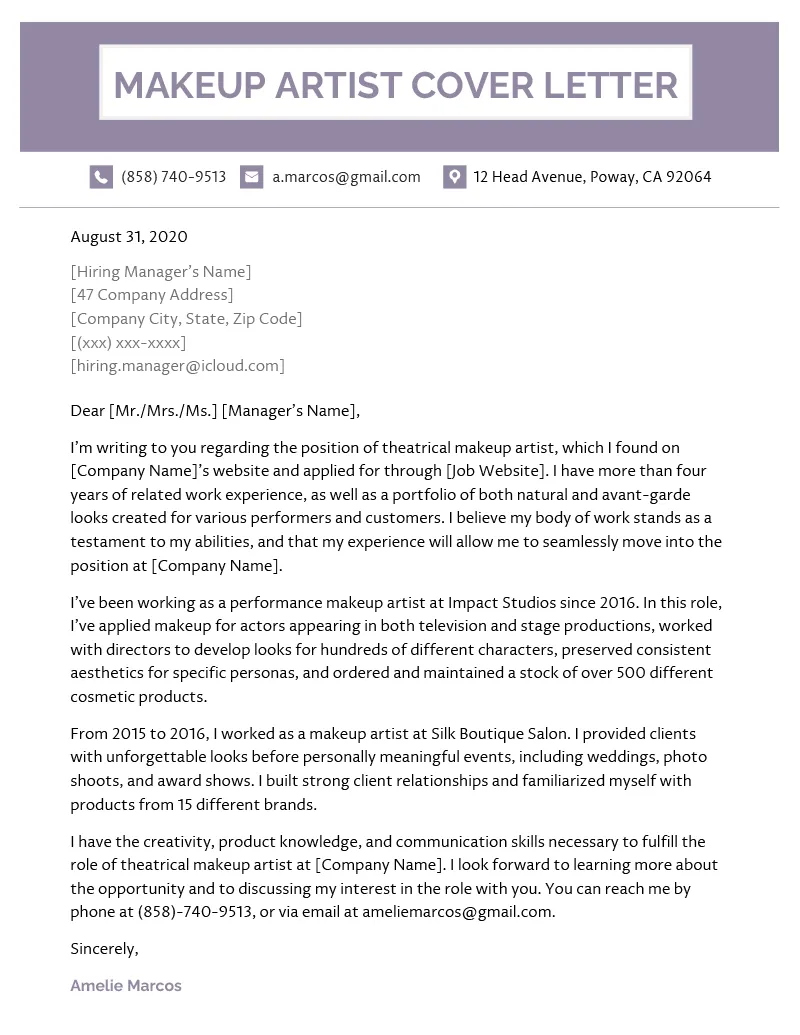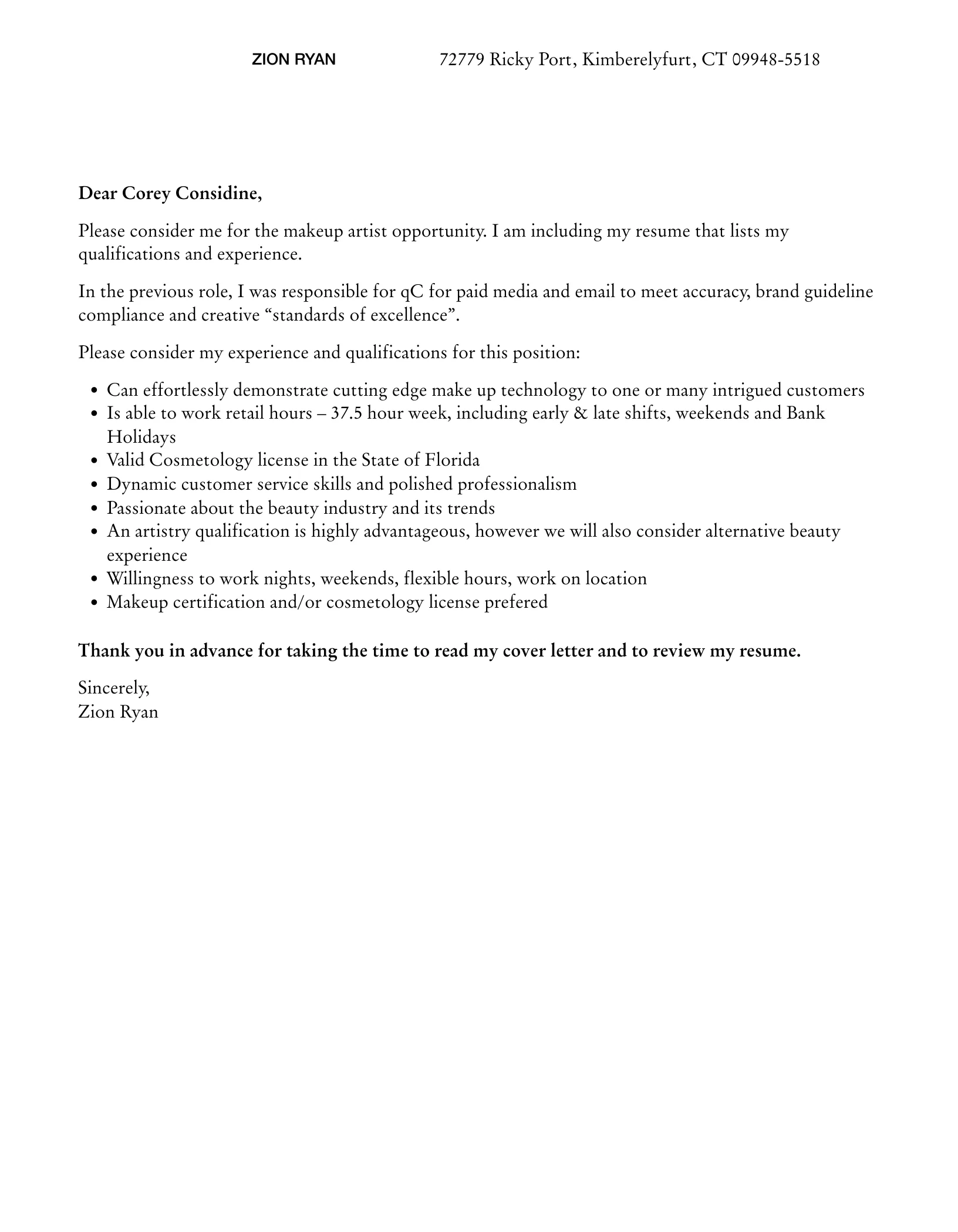Why Your Makeup Artist Cover Letter Matters
In the competitive world of beauty and artistry, a standout cover letter is your initial introduction, serving as a crucial tool to make a positive first impression and secure your dream job as a makeup artist. Unlike a resume, which merely lists your accomplishments, the cover letter provides a platform to express your personality, enthusiasm, and unique approach to makeup artistry. It allows you to elaborate on your skills, showcase your passion for the craft, and demonstrate why you are the perfect fit for a specific opportunity. This document is not just a formality but a strategic means to connect with potential employers on a deeper level, illustrating how your skills and experience align with their specific needs. A well-crafted cover letter demonstrates your commitment and attention to detail, setting the stage for a successful interview and potentially landing you the role.
Highlighting Your Makeup Skills
Your cover letter provides an opportunity to articulate your makeup skills effectively. Start by identifying the core skills that align with the job requirements. This might include expertise in various makeup applications such as airbrushing, bridal, editorial, special effects, or HD makeup. Be specific and avoid generalities. Instead of saying you’re skilled in ‘makeup application,’ describe your proficiency in ‘creating flawless, long-lasting bridal makeup for diverse skin tones’ or ‘mastering avant-garde looks for editorial shoots.’ Moreover, mention any specialized skills you possess, like color correction, contouring and highlighting techniques, or knowledge of different product lines and brands. Back up these claims with concrete examples, demonstrating how you’ve applied these skills in past projects. This specificity not only showcases your expertise but also assures potential employers of your competence and versatility within the field.
Technical Skills for Your Cover Letter

Detailing your technical prowess in your cover letter is essential for demonstrating your competence. Be sure to specify the types of makeup techniques you’re proficient in, such as airbrushing, HD makeup, special effects (SFX), or other specialized areas. Mention your familiarity with different makeup styles, from natural and everyday looks to more complex styles like bridal, editorial, or theatrical makeup. Include information about your knowledge of diverse skin tones, facial features, and how you adapt your techniques accordingly. Highlight your ability to use various tools and products, like brushes, sponges, and different product lines (e.g., MAC, NARS, etc.). Include your understanding of sanitation practices, color theory, and lighting, which ensures you can provide professional-quality work. The more technical details you include, the more you establish yourself as a skilled and knowledgeable makeup artist.
Detailing Your Experience as a Makeup Artist
Your cover letter is the ideal space to provide a narrative of your professional journey. Start by mentioning your experience in the industry. Include the number of years you’ve worked as a makeup artist, whether you’re a recent graduate or a seasoned professional. Outline your past roles, whether they were freelance gigs, salon positions, or work in the film or fashion industries. For each role, describe your responsibilities, such as ‘applying makeup for weddings,’ ‘working on set for photoshoots,’ or ‘consulting with clients to achieve their desired look.’ Quantify your achievements whenever possible. For example, state that you’ve ‘worked on 50+ bridal makeup sessions’ or ‘collaborated on campaigns resulting in X amount of social media engagement.’ Providing context to your responsibilities showcases your ability to make a difference. This helps potential employers understand your capacity for the role you are applying for.
Showcasing Your Portfolio in Your Cover Letter
Your portfolio is your visual resume, and referencing it strategically in your cover letter is critical to impress potential employers. Clearly state where they can view your portfolio, whether it’s a website, Instagram profile, or an attached PDF. Provide a brief overview of your most impressive or relevant projects. Consider highlighting projects that align with the job’s focus. If applying for a bridal makeup position, mention specific bridal work you’ve done. If it’s a fashion-related role, showcase your editorial makeup. Use descriptive language that brings your work to life. Describe the textures, colors, and techniques used in your best pieces. For example, instead of ‘I did a photoshoot,’ write ‘I created a bold, graphic eyeliner look for a high-fashion editorial, achieving a striking contrast with the model’s features.’ Use the cover letter to be an introduction and invite them to delve deeper into your portfolio, encouraging them to envision your capabilities firsthand.
Formatting Your Makeup Artist Cover Letter

A well-formatted cover letter demonstrates professionalism and attention to detail, key qualities employers look for in a makeup artist. Start with a professional header, including your contact information, such as your name, phone number, email address, and social media links if applicable. Address the hiring manager by name if possible, which shows you’ve done your research and are attentive. Choose a standard font, such as Arial or Times New Roman, with a font size between 10 and 12 points for readability. The layout should include clear paragraphs, proper spacing, and bullet points to organize information logically. The goal is for the letter to be easily scannable and visually appealing. Ensure the letter is concise, typically one page long. Keep the content relevant, focusing on skills and experiences that match the job description. A clean and well-organized cover letter reflects your professional approach and makes it easier for the recruiter to find your strengths.
Dos and Don’ts of a Makeup Artist Cover Letter
When crafting your cover letter, there are key practices you should implement and pitfalls to avoid. Do tailor your letter to each job application, highlighting skills and experience that match the specific requirements. Do use a professional tone and proper grammar, ensuring a polished presentation. Do showcase your personality and passion for makeup. And, do proofread carefully for any errors. Conversely, do not use generic templates; personalize your application to stand out. Avoid common mistakes like typos or grammatical errors, as they reflect poorly on your attention to detail. Do not be vague or generic about your experience. Instead, provide specific examples of your work. Avoid the use of jargon and clichés, and always ensure your letter is clear, concise, and tailored to the job.
Customizing Your Cover Letter for Each Job Application
The best cover letters are not generic but customized to reflect the specific needs of each potential employer. Before submitting an application, thoroughly review the job description and pinpoint the core requirements and desired skills. Align your skills, experience, and portfolio examples with these requirements, highlighting how you meet the specific needs of the role. Research the company and the hiring manager to understand their values, mission, and brand aesthetic. This enables you to tailor your language and showcase your understanding of their needs. If the job description emphasizes bridal makeup, focus on your bridal expertise. If it’s a position in a salon, mention your experience working with clients and providing customer service. Use the cover letter to demonstrate your commitment and show how you’re the ideal candidate for their particular job. Customization communicates your dedication to the role, significantly enhancing your chances of making a positive impression.
Proofreading and Editing Your Cover Letter

Proofreading and editing your cover letter are crucial steps to ensure it is free from errors. Start by reading your cover letter multiple times, carefully checking for typos, grammatical errors, and punctuation mistakes. Consider reading your letter aloud to catch any awkward phrasing or unclear sentences. Use grammar and spell-checking tools, but don’t solely rely on them, as they may not detect all issues. Seek feedback from a trusted friend, mentor, or career counselor, who can provide a fresh perspective and identify areas for improvement. They can ensure that your letter is clear, concise, and persuasive. Check the formatting to make sure it’s consistent and professional. The goal is to present a polished and professional document that demonstrates your attention to detail, professionalism, and commitment to excellence. Thorough proofreading is essential to make a favorable impression.
Closing Your Cover Letter Effectively
Your cover letter’s closing should reinforce your interest and leave a lasting positive impression. Thank the hiring manager for considering your application and express your enthusiasm for the opportunity. State your availability for an interview and reiterate your contact information. A strong call to action is beneficial. If the job posting mentions a particular project or skill, reiterate your related experience to remind them. End on a positive and confident note. Express your excitement about the opportunity to discuss your qualifications further, using a professional sign-off such as ‘Sincerely’ or ‘Best regards.’ This assures the potential employer that you are eager, well-prepared, and ready to take the next step in the hiring process. A strong closing is the final opportunity to underscore your professionalism and dedication to securing the role, prompting the hiring manager to contact you.
